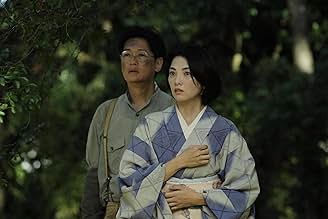Füge eine Handlung in deiner Sprache hinzuA incident happened on 1923 on the Great Kanto earthquakeA incident happened on 1923 on the Great Kanto earthquakeA incident happened on 1923 on the Great Kanto earthquake
- Auszeichnungen
- 2 Gewinne & 4 Nominierungen insgesamt
Empfohlene Bewertungen
Tatsuya Mori's work on the documentaries A and A2 is outstanding, and created a high level of anticipation for this film. The 1923 massacre of ethnic Koreans is under-represented in social discourse, and Mori's documentaries display suitable sensibilities for this project. Framing the story within the killing of Japanese mistaken for Koreans also seems an astute choice in order to give this project as wide an appeal as possible.
It is a shame, then, that the storytelling so greatly disappoints. Having the action take place over several locations is ambitious, but not all of the threads cohere. The ferryboat man and the wandering minstrels from Kagawa are engaging, but the domestic melodramas seem ill-conceived in this narrative. Most egregiously, the travails of a female journalist in a patriarchal press room lead to much speechifying and pontification. Mai Kiryu gives her all to the part, but the character is little more than a walking manifesto.
There is an abundance of acting talent to enjoy. Hakase Suidôbashi does well as a menacing (and ultimately dangerous) buffoon. Masahiro Higashide oozes charisma, and Eita Nagayama is equally magnetic. But no performance is allowed to come to the fore as the focus meanders through the various love betrayals and family reprisals that bloat the running time to 137 minutes. The killing, when it happens, is quite shocking, but the build up to this emotional climax is mishandled.
It is a story worthy of cinematic telling, and it is welcome testimony to an event Japan still fails to squarely face. However, the bottom line is that the power of this story is under-realized in this outing.
It is a shame, then, that the storytelling so greatly disappoints. Having the action take place over several locations is ambitious, but not all of the threads cohere. The ferryboat man and the wandering minstrels from Kagawa are engaging, but the domestic melodramas seem ill-conceived in this narrative. Most egregiously, the travails of a female journalist in a patriarchal press room lead to much speechifying and pontification. Mai Kiryu gives her all to the part, but the character is little more than a walking manifesto.
There is an abundance of acting talent to enjoy. Hakase Suidôbashi does well as a menacing (and ultimately dangerous) buffoon. Masahiro Higashide oozes charisma, and Eita Nagayama is equally magnetic. But no performance is allowed to come to the fore as the focus meanders through the various love betrayals and family reprisals that bloat the running time to 137 minutes. The killing, when it happens, is quite shocking, but the build up to this emotional climax is mishandled.
It is a story worthy of cinematic telling, and it is welcome testimony to an event Japan still fails to squarely face. However, the bottom line is that the power of this story is under-realized in this outing.
Wusstest du schon
- WissenswertesThis film commemorate 100 years of Great Kantô Earthquake and Kantô Massacre.
Top-Auswahl
Melde dich zum Bewerten an und greife auf die Watchlist für personalisierte Empfehlungen zu.
Details
- Erscheinungsdatum
- Herkunftsland
- Offizieller Standort
- Sprache
- Auch bekannt als
- September 1923
- Drehorte
- Produktionsfirmen
- Weitere beteiligte Unternehmen bei IMDbPro anzeigen
- Laufzeit2 Stunden 17 Minuten
- Farbe
- Sound-Mix
Zu dieser Seite beitragen
Bearbeitung vorschlagen oder fehlenden Inhalt hinzufügen

Oberste Lücke
By what name was Fukudamura Jiken (2023) officially released in Canada in English?
Antwort

























